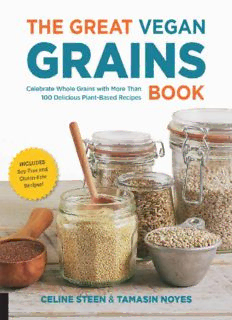
The Great Vegan Grains Book: Celebrate Whole Grains with More than 100 Delicious Plant-Based Recipes * Includes Soy-Free and Gluten-Free Recipes! PDF
Preview The Great Vegan Grains Book: Celebrate Whole Grains with More than 100 Delicious Plant-Based Recipes * Includes Soy-Free and Gluten-Free Recipes!
“The Great Vegan Grains Book is not only informative, but full of deliciously unique and beautifully photographed recipes that are sure to become a fixture in your meal lineup! Celine and Tami share their immense knowledge of grains in a fun, casual, and incredibly tasty way.” —Rose Weitzner, M.D., managing director of the Vegan Trade Council “In their new book, Celine and Tami show you that in order to add whole grains to your diet you don’t have to stop at oatmeal or brown rice. The Great Vegan Grains Book is packed with mouthwatering and unique, often internationally inspired, recipes that will take you on a fantastic journey to explore the amazing world of amaranth, quinoa, spelt, and other wonderful seeds and cereals.” —Constanze Reichardt, founder of seitanismymotor.com THE GREAT VEGAN GRAINS BOOK Celebrate Whole Grains with More Than 100 Delicious Plant-Based Recipes CELINE STEEN & TAMASIN NOYES CONTENTS 1 The Whole Story on Whole Grains 2 Eye-Opening Grains 3 Grain Mains for All Appetites 4 Super Side It with Grains! 5 Great Grain Soups and Salads 6 Spectacular Staples for Kitchen Ease Acknowledgments About the Authors Index 1 THE WHOLE STORY ON WHOLE GRAINS Grains have been a mainstay of the human diet throughout time and across cultures. As societies shifted toward a less nomadic lifestyle, they began to plant grains—from amaranth in Mexico, to barley in Egypt, to rye in Russia, to teff in Ethiopia, and so many more. Whole grains are believed to be some of the earliest cultivated foods, and they have been a vital component in sustaining life all around the world. The popularity of whole grains is well deserved. Grains are delicious, highly nutritious, and packed with fiber, protein, and other key nutrients. We all have increasingly busy lifestyles, and naturally this is reflected in the ways we cook. In this book, we have tried more than ever to offer you easy-to-prepare dishes that don’t sacrifice flavor. Thanks to the diverse and delicious taste of whole grains, it’s easy to use them as a backdrop for fresh vegetables, herbs, and spices, as well as in new and unique ways. What follows is a list of questions (and answers!) to help you get started in exploring a diet richer in whole-grain, plant-based food. WHAT MAKES A GRAIN A WHOLE GRAIN? By definition, whole grains must retain their bran, germ, and endosperm in order to be deserving of the whole grain designation. The bran is the fiber-rich outer layer of the grain kernel. The germ is the nutrient- and protein-rich part of the grain. The endosperm is the germ’s food supply and the largest part of the grain; it is carbohydrate rich and also provides a bit of protein. There are some exceptions to this three-part rule, however. Some grains, such as barley and millet, need to have their inedible outer husks removed so that they’re easier to digest. Such grains are still considered to be whole as they contain all the nutritional benefits found in the original kernel form. Pearled and semipearled grains, on the other hand, cannot be considered whole. Although they offer the advantage of a much shorter cooking time, they are only slightly healthier for you than refined grains because the polishing process removes the bran (the outer layer) of the grain. Even more-refined grains, such as white rice, have the germ removed along with the bran, which definitely turns them into un-whole-y grains. While we’re clearly big fans of whole grains, we also think balance is key. Enjoy refined grains, on occasion, if the mood strikes! WHY EAT WHOLE GRAINS?
